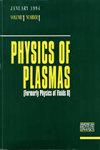An efficient Cherenkov oscillator with an independent injection channel for generating phase-controlled super-radiance pulses
IF 2.2
3区 物理与天体物理
Q3 PHYSICS, FLUIDS & PLASMAS
引用次数: 0
Abstract
An efficient Cherenkov oscillator with gigawatt phase-controlled super-radiance (SR) pulses is studied for the application of coherent summation systems. To obtain phase-controlled SR pulses, an ultra-short seed pulse is required to be injected into the interaction space from the direction of the collector, which substitutes the impact of the spontaneous emission from the front edge of the electron beam. It means that, for a conventional Cherenkov oscillator, the injection seed pulse and output gigawatt SR pulse need to share the same channel. Therefore, an additional quasi-optical reflection system is needed to separate these two signals. To optimize such a scheme, we introduce a front extractor near the reflector and an injection channel at the side of the collector, allowing the output and injection channels to be independent of each other. Particle-in-cell simulations reveal that as the diode voltage is 260 kV, the beam current is 3.5 kA, and the magnetic field is 0.42 T, a short SR pulse with peak power of 1.93 GW is obtained. The corresponding conversion factor (ratio of average output power and input DC power) is up to 2.12. When the seed pulse has a rise time of 0.3 ns and a width of 0.2 ns injection, the phase of the seed pulse and the initiated SR pulse are closely correlated with the accuracy of 0.17 rad as the power ratio is down to −25 dB. The advantages of high efficiency and phase control make the oscillator a promising device used for the miniaturization and practicability of coherent summation systems.具有独立注入通道的高效切伦科夫振荡器,用于产生相位控制的超辐照脉冲
我们研究了一种高效的切伦科夫振荡器,它具有千兆瓦级相位控制超辐射(SR)脉冲,可应用于相干求和系统。为了获得相位控制的 SR 脉冲,需要从集电极方向向相互作用空间注入一个超短种子脉冲,以取代电子束前缘自发辐射的影响。这意味着,对于传统的切伦科夫振荡器来说,注入的种子脉冲和输出的千兆瓦级 SR 脉冲需要共享同一个通道。因此,需要额外的准光学反射系统来分离这两个信号。为了优化这种方案,我们在反射器附近引入了一个前提取器,并在集电极一侧引入了一个注入通道,使输出和注入通道相互独立。粒子内模拟显示,当二极管电压为 260 kV、束流为 3.5 kA、磁场为 0.42 T 时,可获得峰值功率为 1.93 GW 的短 SR 脉冲。相应的转换系数(平均输出功率与输入直流电功率之比)高达 2.12。当种子脉冲的上升时间为 0.3 ns,注入宽度为 0.2 ns 时,种子脉冲和启动的 SR 脉冲的相位密切相关,精度为 0.17 rad,功率比降至 -25 dB。高效率和相位控制的优势使该振荡器成为相干求和系统微型化和实用化的理想器件。
本文章由计算机程序翻译,如有差异,请以英文原文为准。
求助全文
约1分钟内获得全文
求助全文
来源期刊

Physics of Plasmas
物理-物理:流体与等离子体
CiteScore
4.10
自引率
22.70%
发文量
653
审稿时长
2.5 months
期刊介绍:
Physics of Plasmas (PoP), published by AIP Publishing in cooperation with the APS Division of Plasma Physics, is committed to the publication of original research in all areas of experimental and theoretical plasma physics. PoP publishes comprehensive and in-depth review manuscripts covering important areas of study and Special Topics highlighting new and cutting-edge developments in plasma physics. Every year a special issue publishes the invited and review papers from the most recent meeting of the APS Division of Plasma Physics. PoP covers a broad range of important research in this dynamic field, including:
-Basic plasma phenomena, waves, instabilities
-Nonlinear phenomena, turbulence, transport
-Magnetically confined plasmas, heating, confinement
-Inertially confined plasmas, high-energy density plasma science, warm dense matter
-Ionospheric, solar-system, and astrophysical plasmas
-Lasers, particle beams, accelerators, radiation generation
-Radiation emission, absorption, and transport
-Low-temperature plasmas, plasma applications, plasma sources, sheaths
-Dusty plasmas
 求助内容:
求助内容: 应助结果提醒方式:
应助结果提醒方式:


